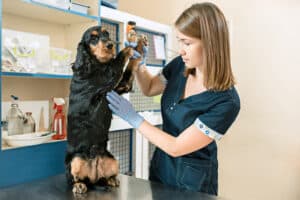Gabapentin is a veterinarian-prescribed medication that controls seizures, anxiety, chronic pain, and nerve pain in dogs. If the drug sounds familiar to you, it’s because it’s also prescribed for humans to manage similar effects and pains. While Gabapentin might not be your veterinarian’s first choice as a nerve pain drug, it is often an alternative treatment when preferred therapies aren’t working.
What is Gabapentin? How much should my dog take? How do I know when to use it? How do I know if I should suggest it to my veterinarian? We answer all these questions and more below, as well as cover dosage, side effects, and alternatives.
What is Gabapentin?
Table of Contents
- 1 What is Gabapentin?
- 2 What Is Gabapentin Used for in Dogs?
- 3 Is Gabapentin Safe for Dogs?
- 4 What’s the Right Gabapentin Dosage for Dogs?
- 5 What Are the Side Effects of Gabapentin in Dogs?
- 6 Drug Interactions With Gabapentin
- 7 What To Do if You Miss a Dose?
- 8 What to Do in the Case of a Gabapentin Overdose?
- 9 Gabapentin Alternatives for Dogs
- 10 Conclusion
Gabapentin is an anticonvulsant (anti-seizure) medication that is prescribed to treat nerve pain, chronic pain, and seizures in dogs. It is sometimes prescribed for cats as a mild sedative to treat the situational anxiety and fear that arises during veterinary visits, and is often combined with other medications to increase effectiveness. There are a few different brand names for Gabapentin including Neurontin®, Aclonium®, Equipax®, Gantin®, Gabarone®, Gralise®, and Neurostil®.
Gabapentin for dogs not only treats seizures but can reduce their frequency, and as an anticonvulsant can even prevent seizures from happening again. For pain relief, Gabapentin is used when other medications are ineffective. It can also be used to treat the pain that’s caused by arthritis, cancer, and intervertebral disk disease.
Gabapentin can be paired with other drugs, such as Trazodone. Trazodone is generally safe when given with Gabapentin, and some veterinarians may prescribe the drugs to reduce anxiety or promote post-surgical rest. Do not give your dog CBD and Gabapentin together, as it can increase the risk of over-sedation. Please consult with your pet’s veterinarian before combining or providing medications.
What Is Gabapentin Used for in Dogs?
Veterinarians use Gabapentin to target seizures and chronic pain, alleviating both in dogs where therapy and other medications have not worked. Gabapentin’s main function is to relieve pain and phobias, and to enable a better quality of life.

Seizures
Veterinarians prescribe Gabapentin for dogs for the maintenance treatment of seizures and epilepsy in our furry friends. It is an adjunct therapy, used to relieve anxiety, pain, and phobias. While Gabapentin is not FDA-approved, its off-label uses are deemed safe by veterinary professionals.
Pain
Gabapentin is an analgesic for nerve pain and chronic pain. In dogs, the most common cause of chronic pain is osteoarthritis—joint pain that flares up as lameness, difficulty moving, limping, and general behavior changes. Veterinarians typically prescribe NSAIDs or nonsteroidal anti-inflammatory drugs as their first choice. Opioids or corticosteroids might be used to treat osteoarthritis, and Gabapentin is an alternative treatment that your veterinarian might add to your dog’s treatment regimen. Your veterinarian will prescribe daily doses of Gabapentin for pain relief.
Anxiety
Gabapentin may be prescribed by your veterinarian to treat anxiety in dogs and cats, especially if they are feeling nervous during their bi-annual checkup. If you notice your dog has become fearful, aggressive, compulsive, or anxious, they might prescribe Gabapentin after suggesting environmental changes and traditional behavior modification. If your dog has been diagnosed with an anxiety disorder, your veterinarian might use medications in addition to additional treatment to help them. SSRIs or selective serotonin reuptake inhibitors and antidepressants may be prescribed, but if they don’t work your veterinarian will prescribe daily doses of Gabapentin or similar drugs. Single doses of Gabapentin can be prescribed to calm a dog before stressful events that trigger phobias. Your veterinarian might also suggest alternatives such as calming dog treats.
Is Gabapentin Safe for Dogs?
Gabapentin is what’s called “off-label” meaning the FDA does not approve its usage in dogs. However, veterinarians consider it safe because there have been no documented cases of it causing serious problems, and your veterinarian will monitor use, dosage, and reaction in your pet.
High dosages of Gabapentin cause sedation and loss of coordination, and Gabapentin should never be given to dogs who are allergic to it. Your veterinarian will adjust the given dosage, especially in dogs that have liver or kidney disease. Depending on your dog’s size, their veterinarian might prescribe smaller doses than the 100 mg capsule, prepared by a specialized pharmacy.
While Gabapentin for dogs is also prescribed for humans to treat similar behavioral problems, human doses like Neurontin should never be given to dogs. Human drugs contain other additives like xylitol which can cause liver damage and hypoglycemia in dogs. Any oral solution of Gabapentin will be prepared by a compounding pharmacy and specially designed for your dog.
What’s the Right Gabapentin Dosage for Dogs?
There are various dosages of Gabapentin that your veterinarian might prescribe based on what the drug is being used to treat. Gabapentin for dogs is available in 100, 300, and 400 mg capsules, as well as a 250 mg oral solution. When the oral solution is formulated with xylitol, your veterinarian will suggest a different form that’s safer for your furbaby to take.
Smaller dogs have a hard time taking human formulations, and a compounding pharmacy can create whatever form and dosage is required by your veterinarian. Gabapentin is given orally 2-4 times per day, with or without food. Your veterinarian will tell you the correct dosage and time frame based on your dog’s needs.
One of the benefits of Gabapentin is that it takes effect fairly quickly, offering relief within two hours of administration. This short-acting drug works for up to 24 hours, which is why it must be administered daily. You also must be careful in continuing dosages for dogs with seizures, as stopping the drug can result in withdrawal epileptic events. Make sure you consult your veterinarian any time you consider discontinuing prescribed medication.
What Are the Side Effects of Gabapentin in Dogs?
There are a few common side effects of Gabapentin in dogs including:
- Lethargy and Exhaustion
- Sedation and Behavioral Changes
- Difficulty Walking
- Poor Balance
These side effects are typically uncommon except for at higher doses. Gabapentin side effects can interfere with your dog’s daily habits and function, and you should always check with your veterinarian before changing doses or discontinuing the medication. At higher doses, your dog might experience vomiting or diarrhea, but these are less common side effects. Most side effects caused by Gabapentin will also go away after 8-12 hours.
There are a few serious, but uncommon, side effects when Gabapentin is used at its prescribed doses. Gabapentin also needs to be used carefully in dogs who have liver or kidney disease, as these side effects might take longer to wear off. Higher doses of Gabapentin for dogs can cause more pronounced sedation and imbalances, and you should avoid using the medication in pregnant and lactating dogs.
The human/liquid formulation of Gabapentin must NOT be used in dogs as it contains the artificial sweetener xylitol, which is toxic for pets. If you believe your dog has taken the incorrect dosage or you notice any serious side effects, it’s important to contact your veterinarian immediately.
Drug Interactions With Gabapentin
Gabapentin can interact with the following drugs:
- Antacids
- Any product that contains aluminum, magnesium, or calcium
- Central nervous system depressants
- Cannabidiol (CBD)
- Opioid pain medications
- Tramadol and Codeine
- Xanax
Always check with your veterinarian, and only use Gabapentin for dogs under your veterinarian’s direction. Dosing or frequency might need to be changed depending on what other medications your dog is taking.
What To Do if You Miss a Dose?
If you accidentally miss giving your dog a dosage, it’s best to wait until the next one instead of trying to make up the missed dose. If you give your dog Gabapentin too soon, you might risk sedation. If you’re concerned that your dog might suffer pain or seizures from missing a dose, you can give another one as long as they are 8 hours apart. Contact your veterinarian immediately if you notice any problems.
What to Do in the Case of a Gabapentin Overdose?
An overdose of Gabapentin increases the severity of its side effects, including sleepiness, lethargy, clumsiness, and depression. Sedation is one of the biggest side effects of Gabapentin. If you believe your pet has overdosed on Gabapentin or any pet medication, contact your veterinarian immediately or call the A.S.P.C.A.’s Animal Poison Control Center at 888-426-4435. You can also call the National Capital Poison Center at 800-222-1222.
Gabapentin Alternatives for Dogs
Your veterinarian might prescribe a Gabapentin alternative if your dog doesn’t tolerate the drug, has an allergy, or has liver or kidney issues that make Gabapentin dosages dangerous. Gabapentin for dogs is most commonly used to treat nerve pain, and there are other effective nerve pain treatments such as Lyrica and Amantadine. Medications such as Pregabalin last longer than Gabapentin, so it’s important to listen to your veterinarian when they are outlining dosages and time frames.
Conclusion
Gabapentin is a powerful, effective drug that when used properly can help prevent chronic pain and seizures in your dog. It’s important to only use Gabapentin and any other medication as per your veterinarian’s specific instructions. If you have any questions about Gabapentin or any other medication, speak to a trusted veterinarian such as those at Paoli Vetcare.
Paoli Vetcare’s knowledgeable staff of veterinarians can also suggest alternatives, provide safety education, and advise you on the best way to administer the drug. Please contact Paoli Vetcare for more information, especially if you have any questions or concerns about your pet. We can’t wait to hear from you!








